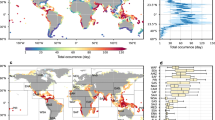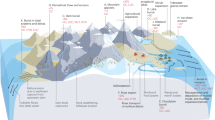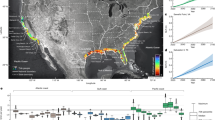Abstract
Salt marshes are important coastal habitats and provide ecosystem services to surrounding communities. They are, however, threatened by accelerating sea-level rise and sediment deprivation due to human activity within upstream catchments, which result in their drowning and a reduction in their extent. Rising seas are also leading to an expansion of coastal flooding protection infrastructures, which might also represent another serious if poorly understood threat to salt marshes due to effects on the resuspension and accumulation of sediment during storms. Here, we use observations from the Venice Lagoon (Italy), a back-barrier system with no fluvial sediment input recently protected by storm-surge barriers, to show that most of the salt-marsh sedimentation (more than 70% in this case) occurs due to sediment reworking during storm surges. We also prove that the large, yet episodic storm-driven sediment supply is seriously reduced by operations of storm-surge barriers, revealing a critical competition between the objectives of protection against coastal flooding and preservation of natural ecosystems. Without complementary interventions and management policies that reduce barrier activations, the survival of coastal wetlands is even more uncertain.
This is a preview of subscription content, access via your institution
Access options
Access Nature and 54 other Nature Portfolio journals
Get Nature+, our best-value online-access subscription
$29.99 / 30 days
cancel any time
Subscribe to this journal
Receive 12 print issues and online access
$259.00 per year
only $21.58 per issue
Buy this article
- Purchase on Springer Link
- Instant access to full article PDF
Prices may be subject to local taxes which are calculated during checkout




Similar content being viewed by others
Data availability
All data are available at http://researchdata.cab.unipd.it/id/eprint/416. Meteorological data are also available at https://www.comune.venezia.it/content/dati-dalle-stazioni-rilevamento and https://www.venezia.isprambiente.it/rete-meteo-mareografica.
Code availability
We used the program MATLAB (R2020b) to generate all the results. Analysis scripts are available at http://researchdata.cab.unipd.it/id/eprint/416.
References
Barbier, E. B. et al. The value of estuarine and coastal ecosystem services. Ecol. Monogr. https://doi.org/10.1890/10-1510.1 (2011).
Costanza, R. et al. The value of the world’s ecosystem services and natural capital. Nature 387, 253–260 (1997).
Chmura, G. L., Anisfeld, S. C., Cahoon, D. R. & Lynch, J. C. Global carbon sequestration in tidal, saline wetland soils. Glob. Biogeochem. Cycles https://doi.org/10.1029/2002GB001917 (2003).
Kirwan, M. L. & Mudd, S. M. Response of salt-marsh carbon accumulation to climate change. Nature 489, 550–553 (2012).
Möller, I. et al. Wave attenuation over coastal salt marshes under storm surge conditions. Nat. Geosci. 7, 727–731 (2014).
Syvitski, J. P. M., Vörösmarty, C. J., Kettner, A. J. & Green, P. Impact of humans on the flux of terrestrial sediment to the global coastal ocean. Science https://doi.org/10.1126/science.1109454 (2005).
D’Alpaos, A., Mudd, S. M. & Carniello, L. Dynamic response of marshes to perturbations in suspended sediment concentrations and rates of relative sea level rise. J. Geophys. Res. Earth Surf. 116, F04020 (2011).
FitzGerald, D. M. & Hughes, Z. J. Marsh processes and their response to climate change and sea-level rise. Annu. Rev. Earth Planet. Sci. https://doi.org/10.1146/annurev-earth-082517-010255 (2019).
Kirwan, M. L. & Megonigal, J. P. Tidal wetland stability in the face of human impacts and sea-level rise. Nature 504, 53–60 (2013).
Marani, M., D’Alpaos, A., Lanzoni, S., Carniello, L. & Rinaldo, A. The importance of being coupled: stable states and catastrophic shifts in tidal biomorphodynamics. J. Geophys. Res. Earth Surf. 115, F04004 (2010).
Schuerch, M. et al. Future response of global coastal wetlands to sea-level rise. Nature 561, 231–234 (2018).
Carniello, L., Defina, A. & D’Alpaos, L. Morphological evolution of the Venice Lagoon: evidence from the past and trend for the future. J. Geophys. Res. Earth Surf. https://doi.org/10.1029/2008JF001157 (2009).
Morris, J. T., Sundareshwar, P. V., Nietch, C. T., Kjerfve, B. & Cahoon, D. R. Responses of coastal wetlands to rising sea level. Ecology 83, 2869–2877 (2002).
Reed, D. J. The response of coastal marshes to sea‐level rise: survival or submergence? Earth Surf. Process. Landf. 20, 39–48 (1995).
Marani, M., D’Alpaos, A., Lanzoni, S. & Santalucia, M. Understanding and predicting wave erosion of marsh edges. Geophys. Res. Lett. https://doi.org/10.1029/2011GL048995 (2011).
Mariotti, G. & Fagherazzi, S. Wind waves on a mudflat: the influence of fetch and depth on bed shear stresses. Cont. Shelf Res. https://doi.org/10.1016/j.csr.2012.03.001 (2013).
Mariotti, G. & Carr, J. Dual role of salt marsh retreat: long-term loss and short-term resilience. Water Resour. Res. 50, 2963–2974 (2014).
Tommasini, L., Carniello, L., Ghinassi, M., Roner, M. & D’Alpaos, A. Changes in the wind-wave field and related salt-marsh lateral erosion: inferences from the evolution of the Venice Lagoon in the last four centuries. Earth Surf. Process. Landf. 44, 1633–1646 (2019).
Fagherazzi, S. et al. Numerical models of salt marsh evolution: ecological, geomorphic, and climatic factors. Rev. Geophys. https://doi.org/10.1029/2011RG000359 (2012).
Marani, M., D’Alpaos, A., Lanzoni, S., Carniello, L. & Rinaldo, A. Biologically-controlled multiple equilibria of tidal landforms and the fate of the Venice Lagoon. Geophys. Res. Lett. 34, L11402 (2007).
Marani, M., Da Lio, C. & D’Alpaos, A. Vegetation engineers marsh morphology through multiple competing stable states. Proc. Natl Acad. Sci. USA https://doi.org/10.1073/pnas.1218327110 (2013).
Ratliff, K. M., Braswell, A. E. & Marani, M. Spatial response of coastal marshes to increased atmospheric CO2. Proc. Natl Acad. Sci. USA 112, 15580–15584 (2015).
Carniello, L. et al. Sediment dynamics in shallow tidal basins: in situ observations, satellite retrievals, and numerical modeling in the Venice Lagoon. J. Geophys. Res. Earth Surf. 119, 802–815 (2014).
Green, M. O. & Coco, G. Review of wave-driven sediment resuspension and transport in estuaries. Rev. Geophys. https://doi.org/10.1002/2013RG000437 (2014).
Leonardi, N. et al. Dynamic interactions between coastal storms and salt marshes: a review. Geomorphology https://doi.org/10.1016/j.geomorph.2017.11.001 (2018).
Castagno, K. A. et al. Intense storms increase the stability of tidal bays. Geophys. Res. Lett. 45, 5491–5500 (2018).
Goodwin, G. C. H. & Mudd, S. M. High platform elevations highlight the role of storms and spring tides in salt marsh evolution. Front. Environ. Sci. 7, 62 (2019).
Cahoon, D. R. et al. The influence of Hurricane Andrew on sediment distribution in Louisiana coastal marshes. J. Coast. Res. 21, 280–294 (1995).
Tweel, A. W. & Turner, R. E. Contribution of tropical cyclones to the sediment budget for coastal wetlands in Louisiana, USA. Landsc. Ecol. 29, 1083–1094 (2014).
Du, J., Park, K., Dellapenna, T. M. & Clay, J. M. Dramatic hydrodynamic and sedimentary responses in Galveston Bay and adjacent inner shelf to Hurricane Harvey. Sci. Total Environ. 653, 554–564 (2019).
Gedan, K. B., Silliman, B. R. & Bertness, M. D. Centuries of human-driven change in salt marsh ecosystems. Annu. Rev. Mar. Sci. 1, 117–141 (2009).
Rodríguez, J. F., Saco, P. M., Sandi, S. G., Saintilan, N. & Riccardi, G. Potential increase in coastal wetland vulnerability to sea-level rise suggested by considering hydrodynamic attenuation effects. Nat. Commun. 8, 16094 (2017).
Sandi, S. G., Rodríguez, J. F., Saintilan, N., Riccardi, G. & Saco, P. M. Rising tides, rising gates: the complex ecogeomorphic response of coastal wetlands to sea-level rise and human interventions. Adv. Water Resour. 114, 135–148 (2018).
Silvestri, S., D’Alpaos, A., Nordio, G. & Carniello, L. Anthropogenic modifications can significantly influence the local mean sea level and affect the survival of salt marshes in shallow tidal systems. J. Geophys. Res. Earth Surf. 123, 996–1012 (2018).
Temmerman, S. et al. Ecosystem-based coastal defence in the face of global change. Nature 504, 79–83 (2013).
Mooyaart, L. F. & Jonkman, S. N. Overview and design considerations of storm surge barriers. J. Waterw. Port. Coast. Ocean Eng. 143, 06017001 (2017).
Eprim, Y. in Flooding and Environmental Challenges for Venice and its Lagoon: State of Knowledge (eds Fletcher C. A. & Spencer T.) 257–262 (Cambridge Univ. Press, 2005).
Morris, J. T. et al. Contributions of organic and inorganic matter to sediment volume and accretion in tidal wetlands at steady state. Earth’s Future 4, 110–121 (2016).
Stumpf, R. P. The process of sedimentation on the surface of a salt marsh. Estuar. Coast. Shelf Sci. 17, 495–508 (1983).
Roner, M. et al. Latest Holocene depositional history of the southern Venice Lagoon, Italy. Holocene 27, 1731–1744 (2017).
Allen, J. R. L. Salt-marsh growth and fluctuating sea level: implications of a simulation model for Flandrian coastal stratigraphy and peat-based sea-level curves. Sediment. Geol. 100, 21–45 (1995).
French, J. R. Numerical simulation of vertical marsh growth and adjustment to accelerated sea-level rise, north Norfolk, U.K. Earth Surf. Process. Landf. 18, 63–81 (1993).
Temmerman, S., Govers, G., Wartel, S. & Meire, P. Spatial and temporal factors controlling short-term sedimentation in a salt and freshwater tidal marsh, Scheldt Estuary, Belgium, SW Netherlands. Earth Surf. Process. Landf. 28, 739–755 (2003).
D’Alpaos, A., Carniello, L. & Rinaldo, A. Statistical mechanics of wind wave-induced erosion in shallow tidal basins: inferences from the Venice Lagoon. Geophys. Res. Lett. https://doi.org/10.1002/grl.50666 (2013).
Carniello, L., D’Alpaos, A., Botter, G. & Rinaldo, A. Statistical characterization of spatiotemporal sediment dynamics in the Venice Lagoon. J. Geophys. Res. Earth Surf. https://doi.org/10.1002/2015JF003793 (2016).
Carniello, L., D’Alpaos, A. & Defina, A. Modeling wind waves and tidal flows in shallow micro-tidal basins. Estuar. Coast. Shelf Sci. 92, 263–276 (2011).
Mel, R., Carniello, L. & D’Alpaos, L. Addressing the effect of the Mo.S.E. barriers closure on wind setup within the Venice Lagoon. Estuar. Coast. Shelf Sci. 225, 106249 (2019).
Carbognin, L., Teatini, P. & Tosi, L. Eustacy and land subsidence in the Venice Lagoon at the beginning of the new millennium. J. Mar. Syst. https://doi.org/10.1016/j.jmarsys.2004.05.021 (2004).
Kirwan, M. L., Murray, A. B., Donnelly, J. P. & Corbett, D. R. Rapid wetland expansion during European settlement and its implication for marsh survival under modern sediment delivery rates. Geology 39, 507–510 (2011).
Defina, A., Carniello, L., Fagherazzi, S. & D’Alpaos, L. Self-organization of shallow basins in tidal flats and salt marshes. J. Geophys. Res. Earth Surf. 112, F03001 (2007).
Nolte, S. et al. Measuring sedimentation in tidal marshes: a review on methods and their applicability in biogeomorphological studies. J. Coast. Conserv. 17, 301–325 (2013).
Thomas, S. & Ridd, P. V. Review of methods to measure short time scale sediment accumulation. Mar. Geol. 207, 95–114 (2004).
Ball, D. F. Loss‐on‐ignition as an estimate of organic matter and organic carbon in non‐calcareous soils. J. Soil Sci. 15, 84–92 (1964).
Roner, M. et al. Spatial variation of salt-marsh organic and inorganic deposition and organic carbon accumulation: inferences from the Venice Lagoon, Italy. Adv. Water Resour. https://doi.org/10.1016/j.advwatres.2015.11.011 (2016).
Craft, C. B., Seneca, E. D. & Broome, S. W. Vertical accretion in microtidal regularly and irregularly flooded estuarine marshes. Estuar. Coast. Shelf Sci. https://doi.org/10.1006/ecss.1993.1062 (1993).
Carniello, L., Defina, A., Fagherazzi, S. & D’Alpaos, L. A combined wind wave-tidal model for the Venice Lagoon, Italy. J. Geophys. Res. Earth Surf. 110, F04007 (2005).
Acknowledgements
The authors thank the technical staff of the Department of Biology and the Department of Geosciences, University of Padova, for fieldwork and laboratory analysis support. This scientific activity was performed as part of the Research Programme Venezia2021, with contributions from the Provveditorato for the Public Works of Veneto, Trentino Alto Adige and Friuli Venezia Giulia, provided through the concessionary of State Consorzio Venezia Nuova and coordinated by CORILA, Research Line 3.2 (PI A.D.) and by the 2019 University of Padova project (BIRD199419) ‘Tidal network ontogeny and evolution: a comprehensive approach based on laboratory experiments with ancillary numerical modelling and field measurements’ (PI L.C.).
Author information
Authors and Affiliations
Contributions
D.T., A.D., L.C. and M.M. designed the research. D.T. and L.C. conducted the fieldwork. D.T. performed the research and analysed the data. D.T. prepared the figures and wrote the first draft of the manuscript, which was subsequently improved by feedback from A.D., L.C. and M.M. The present work represents one of the outcomes of the PhD thesis by D.T., supervised by L.C.
Corresponding author
Ethics declarations
Competing interests
The authors declare no competing interests.
Additional information
Peer review information Nature Geoscience thanks Tracy Elsey-Quirk and the other, anonymous, reviewer(s) for their contribution to the peer review of this work. Primary Handling Editor: James Super.
Publisher’s note Springer Nature remains neutral with regard to jurisdictional claims in published maps and institutional affiliations.
Extended data
Extended Data Fig. 1 Organic matter content.
(a-c-e) organic matter accumulation (bars) and organic matter accumulation rate (solid circles); (b-d-f) organic matter as percentage of weight. The cloud symbol indicates storm periods. Data are grouped for study area: SF (a-b), SE (c-d) and CO (e-f). Alternate white and grey background indicates different observation periods.
Extended Data Fig. 2 Storm-related sedimentation.
Percentage of sedimentation (a) and percentage of time (b) related to storm events and to fair-weather conditions. Categories refer to the study areas (SF, SE and CO) and their mean (darker colour); subscripts indicate the beginning of the grouping period: O18, from October 2018 to October 2019, J19 from January 2019 to January 2020 and O19 from October 2019 to October 2020.
Extended Data Fig. 3 Sediment accumulation changes in the flood regulated scenario.
Comparison between measured data (grey bars), sediment accumulation modelled in the non-regulated (teal bars) and regulated scenario (yellow bars) for each study area: SF (a), SE (b) and CO (c). Alternate white and grey background indicates different observation periods, hatched background indicates periods with actual closures of flood barriers. The cloud symbol indicates storm-dominated periods.
Extended Data Fig. 4 Vertical accretion changes in the flood regulated scenario.
Comparison between measured data (grey bars), vertical accretion modelled in the non-regulated (teal bars) and regulated scenario (yellow bars) for each study area: SF (a), SE (b) and CO (c). Lines represent cumulative accretion rates and black solid circles are yearly horizon marker measurements. Alternate white and grey background indicates different observation periods, hatched background indicates periods with actual closures of flood barriers. The cloud symbol indicates storm-dominated periods.
Extended Data Fig. 5 Sediment accumulation changes in the flood-regulated scenario at yearly time scale.
Change in sediment accumulation between the non-regulated (teal bars) and regulated scenario (yellow bars). Categories refer to the study areas (SF, SE and CO) or their mean. Subscripts indicate the beginning of the grouping period: O18, from October 2018 to October 2019, O19, from October 2019 to October 2020. Percentages indicate the relative change in the flood-regulated scenario with respect to the non-regulated one (see also Supplementary Tables 3 and 4).
Extended Data Fig. 6 Sedimentation changes due to flood-regulation during autumn.
Comparison between measured data (grey bars), modelled data in the non-regulated (teal bars) and regulated scenario (yellow bars) summed for autumnal months (October, November and December) for each study area: SF (a), SE (b), CO (c) and their mean (d). In autumn 2020 the flood barriers were used, so measurements refer to the flood-regulated condition.
Supplementary information
Supplementary information
Supplementary Figs. 1–3, Tables 1–4 and discussion.
Rights and permissions
About this article
Cite this article
Tognin, D., D’Alpaos, A., Marani, M. et al. Marsh resilience to sea-level rise reduced by storm-surge barriers in the Venice Lagoon. Nat. Geosci. 14, 906–911 (2021). https://doi.org/10.1038/s41561-021-00853-7
Received:
Accepted:
Published:
Issue Date:
DOI: https://doi.org/10.1038/s41561-021-00853-7
This article is cited by
-
Vertical accretion trends project doughnut-like fragmentation of saltmarshes
Communications Earth & Environment (2024)
-
Sustained increase in suspended sediments near global river deltas over the past two decades
Nature Communications (2024)
-
Boon and burden: economic performance and future perspectives of the Venice flood protection system
Regional Environmental Change (2024)
-
Geomorphic and ecological constraints on the coastal carbon sink
Nature Reviews Earth & Environment (2023)
-
Quantifying the effects of sea level rise driven marsh migration on wave attenuation
Environmental Monitoring and Assessment (2023)



